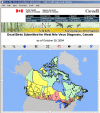A GIS-driven integrated real-time surveillance pilot system for national West Nile virus dead bird surveillance in Canada
- PMID: 16626490
- PMCID: PMC1482309
- DOI: 10.1186/1476-072X-5-17
A GIS-driven integrated real-time surveillance pilot system for national West Nile virus dead bird surveillance in Canada
Abstract
Background: An extensive West Nile virus surveillance program of dead birds, mosquitoes, horses, and human infection has been launched as a result of West Nile virus first being reported in Canada in 2001. Some desktop and web GIS have been applied to West Nile virus dead bird surveillance. There have been urgent needs for a comprehensive GIS services and real-time surveillance.
Results: A pilot system was developed to integrate real-time surveillance, real-time GIS, and Open GIS technology in order to enhance West Nile virus dead bird surveillance in Canada. Driven and linked by the newly developed real-time web GIS technology, this integrated real-time surveillance system includes conventional real-time web-based surveillance components, integrated real-time GIS components, and integrated Open GIS components. The pilot system identified the major GIS functions and capacities that may be important to public health surveillance. The six web GIS clients provide a wide range of GIS tools for public health surveillance. The pilot system has been serving Canadian national West Nile virus dead bird surveillance since 2005 and is adaptable to serve other disease surveillance.
Conclusion: This pilot system has streamlined, enriched and enhanced national West Nile virus dead bird surveillance in Canada, improved productivity, and reduced operation cost. Its real-time GIS technology, static map technology, WMS integration, and its integration with non-GIS real-time surveillance system made this pilot system unique in surveillance and public health GIS.
Figures








References
-
- Public Health Agency of Canada West Nile virus – History. 2005. http://www.phac-aspc.gc.ca/wn-no/index_e.html
-
- Public Health Agency of Canada Human Results – 2005 Program: West Nile Virus Neurological Syndromes, West Nile Virus Non-Neurological Syndrome and West Nile Virus Asymptomatic Infection, Diagnosis by Health Region, Canada as of September 17, 2005. 2005. http://dsol-smed.phac-aspc.gc.ca/wnv3/map_e.phtml?appname=human
-
- British Columbia Centre for Disease Control Interactive GIS Mapping for West Nile Virus. 2006. http://maps.bccdc.org
Publication types
MeSH terms
LinkOut - more resources
Full Text Sources
Medical

